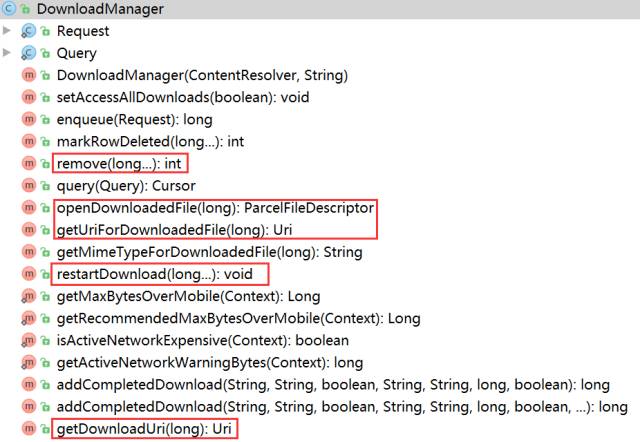(点击
上方公众号
,可快速关注)
来源:Marno
http://www.jianshu.com/p/46fd1c253701
如有好文章投稿,请点击 → 这里了解详情
写在前面的废话
下载文件,几乎是所有APP都会用到的功能!算了,还是不废话了,直接开写吧。。。
简单使用
完成一个下载任务只需要4行代码,什么断点续传,大文件下载,通知栏进度显示….都不需要你操心。
//创建下载任务,downloadUrl就是下载链接
DownloadManager
.
Request
request
=
new
DownloadManager
.
Request
(
Uri
.
parse
(
downloadUrl
));
//指定下载路径和下载文件名
request
.
setDestinationInExternalPublicDir
(
"/download/"
,
fileName
);
//获取下载管理器
DownloadManager
downloadManager
=
(
DownloadManager
)
mContext
.
getSystemService
(
Context
.
DOWNLOAD_SERVICE
);
//将下载任务加入下载队列,否则不会进行下载
downloadManager
.
enqueue
(
request
);
高级用法
让我们看DownloadManager的源码,提供了这么多方法

DownloadManager的方法

DownloadManager.Request的方法
实际使用
接下来我们就以APP应用内更新为例,讲一下这些方法的使用
1.首先我们梳理下APP应用内更新的逻辑

APP应用内更新
2.接下来看具体实现,上代码
//使用系统下载器下载
private
void
downloadAPK
(
String
versionUrl
,
String
versionName
)
{
//创建下载任务
DownloadManager
.
Request
request
=
new
DownloadManager
.
Request
(
Uri
.
parse
(
versionUrl
));
request
.
setAllowedOverRoaming
(
false
);
//漫游网络是否可以下载
//设置文件类型,可以在下载结束后自动打开该文件
MimeTypeMap
mimeTypeMap
=
MimeTypeMap
.
getSingleton
();
String
mimeString
=
mimeTypeMap
.
getMimeTypeFromExtension
(
MimeTypeMap
.
getFileExtensionFromUrl
(
versionUrl
));
request
.
setMimeType
(
mimeString
);
//在通知栏中显示,默认就是显示的
request
.
setNotificationVisibility
(
DownloadManager
.
Request
.
VISIBILITY_VISIBLE
);
request
.
setVisibleInDownloadsUi
(
true
);
//sdcard的目录下的download文件夹,必须设置
request
.
setDestinationInExternalPublicDir
(
"/download/"
,
versionName
);
//request.setDestinationInExternalFilesDir(),也可以自己制定下载路径
//将下载请求加入下载队列
downloadManager
=
(
DownloadManager
)
mContext
.
getSystemService
(
Context
.
DOWNLOAD_SERVICE
);
//加入下载队列后会给该任务返回一个long型的id,
//通过该id可以取消任务,重启任务等等,看上面源码中框起来的方法
mTaskId
=
downloadManager
.
enqueue
(
request
);
//注册广播接收者,监听下载状态
mContext
.
registerReceiver
(
receiver
,
new
IntentFilter
(
DownloadManager
.
ACTION_DOWNLOAD_COMPLETE
));
}
接下来是广播接收器
//广播接受者,接收下载状态
private
BroadcastReceiver
receiver
=
new
BroadcastReceiver
()
{
@Override
public
void
onReceive
(





